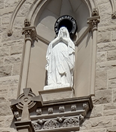Saint: Difference between revisions
Appearance
Tags: Manual revert Visual edit |
|||
| Line 80: | Line 80: | ||
''all the Angels and Saints, and you, my brothers and sisters,'' | ''all the Angels and Saints, and you, my brothers and sisters,'' | ||
''to pray for me to the Lord our God'' | ''to pray for me to the Lord our God'' | ||
* see [[Intercession]] entry for more | |||
== The "Communion of Saints" == | == The "Communion of Saints" == | ||
Revision as of 15:22, 20 February 2024
also, Saint, Saints, the Saints, saint,
abbreviation: "St."
- expanded entry from Glossary entry for "Saint"
A saint is
- a “holy one”
- someone in heaven
- a model Christian
- an intercessor
"Sainthood" refers to status as a Saint
Saint overview
- someone "who leads a life in union with God through the grace of Christ and receives the reward of eternal life” (CCC Glossary)
- and a "model" Christian and "intercessor" (CCC 828)
- Saints may intercede to the Lord on our behalf
- also, members of the Church are "saints" (CCC 823)
Characteristics of Saints
| Criteria | Check |
|---|---|
| Holiness | ✓ |
| Model of Christian Life | ✓ |
| Teacher of the Church | ✓ |
| Intercessor | ✓ |
| Miracles | ✓ |
| Martyrdom | ✓ |
- Saints have all or some of the following characteristics or acts:
- "holiness" (acting like and by the standards of God and under God's Grace)
- a model or noteworthy Christian life
- a teacher of the Church
- conducted (a) miracle(s) in life or through intercession (i.e. after death, interceded on behalf of someone who prayed in their name)
- intercessor to the Lord
- martyrdom (dying for God)
Early Christians
- early Christians considered the martyrs saints, as they were certain to be with God for their allegiance and sacrifice to the Lord:
- they were known as "saints for sure"
- and their death dates, burial sites and remains became the focus of worship
- the closer to the "relic" of a saint the closer to God
Criteria for Sainthood: canonization
- the title "Saint" is for someone "canonized" by the Church:
- = declared and holder of the "Keys of the Kingdom of Heaven" by the Pope
- i.e., Saints are declared to be in Heaven
- (note: the Church never declares that anyone is in Hell or Purgatory)
- = declared and holder of the "Keys of the Kingdom of Heaven" by the Pope
“The solemn declaration by the Pope that a deceased member of the faithful may be proposed as a model and intercessor to the Christian faithful and venerated as a saint on the basis of the fact that the person lived a life of heroic virtue or remained faithful to God through martyrdom” (CCC Glossary)
Prayer to the Saints
- Saints are examples
- to admire
- to follow
- to adopt
- Saints are intercessors
- which is why we pray to the Saints to intercede to God on our behalf
- ex. From the Confiteor (“I confess…”):
therefore I ask blessed Mary ever-Virgin, all the Angels and Saints, and you, my brothers and sisters, to pray for me to the Lord our God
- see Intercession entry for more
The "Communion of Saints"
- in the Creeds we profess "the communion of saints"
- the "communion of saints" = the Church
- it also means the Saints in Heaven who
- the "communion of saints" = the Church
"do not cease to intercede with the Father for us, as they proffer the merits which they acquired on earth through the one mediator between God and men, Christ Jesus"(CCC 956)
Celebration of Saints:
- Feast days are the day of their death, called their "heavenly birthday"
- sometimes, the date may be changed, depending on other Feasts and liturgical (worship) celebrations
- ex. Saint Thomas More's feast day is June 22, while he was martyred on July 5 for refusing to take an oath proclaiming the King of England, Henry VIII, head of the Church in England (i.e. breaking with the Catholic Church)
- he was beheaded on July 6, but his Feast day was set initially for July 9 (?), then moved to June 22 to align with the martyrdom of his fellow champion of the Church, Saint John Fisher, who was martyred on June 22 for the same reasons as St. Thomas More.
- sometimes, the date may be changed, depending on other Feasts and liturgical (worship) celebrations
- Saint symbols are related to their charism and/or means of death, such as:
- St. Roch is depicted with a Pilgrim's staff and/or a wound on his thigh
- Saint Thomas more was beheaded, so one of his symbols is double-headed axe
- Saints may be "patrons" or protectors, symbols for, or representative of a cause, profession, illness, body part, etc.
- St. Roch, patron saint of dogs, the plague, and invalids, (among things)
- because after curing the sick, he became sick himself and retreated to the woods, where a dog brought him food and healed his wounds by licking them
- St. Roch, patron saint of dogs, the plague, and invalids, (among things)
- for more:
- "Reading the Church Fathers: A History of the Early Church and the Development of Doctrine," by James L. Papandrea, p 80
- Patron Saints A-Z - Saints & Angels - Catholic Online
